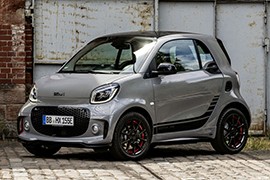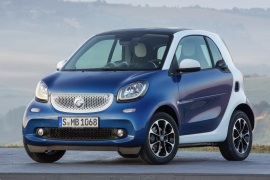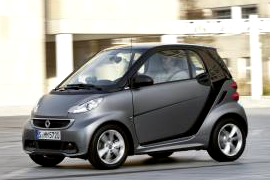

Mercedes-Benz worked with the French automaker Renault when it made the third generation of the smart fortwo, launched in 2014. Fast forward three years, and the electric versions of this city car got rebranded and received the EQ badge behind the brand’s name, following the same system introduced by the three-pointed star automaker for its electric vehicles. Only a year later, in the autumn of 2019, the new smart-EQ received a facelift for both its fortwo coupe and fortwo cabriolet versions. In addition, the automaker pulled the plug on the ICE versions for the entire range, including the fourfour. Thus, the brand returned to its original idea of an all-electric vehicle made for the urban environment.
At the front, the car sported a smiling-shaped lower grille flanked on the sides by scoops and the optional fog lamps. In addition, the headlights got a slight reshape and integrated daytime running lights, which surrounded the inner sides of the headlamps. Starting with the 2019 fortwo, the car also got LED lights that improved the nighttime driving experience and lowered the energy consumption compared to halogen or Xenon bulbs. From its profile, the fortwo featured a steep windshield and a short roof. Behind the thick B-pillars, the automaker installed the vertical tailgate, adorned on its upper side by plastic trims and a roof spoiler.
The cabin was refreshed compared to the 2016 model and featured tall seatbacks with integrated headrests. Fronting the driver was a classic smart instrument cluster with a TFT display surrounded by an analog dial for the speedometer. Mercedes-Benz added a new infotainment unit on the center stack, supporting Bluetooth connectivity. The standard version came well-equipped and included AC and heated seats. Underneath it, on the center console, the automaker placed the gear selector, two cup holders, and a tiny drawer on the side for some coins or headphones. Behind the tiny cabin was a briefcase-sized trunk placed above the rear axle and the electric motor.
Mercedes-Benz installed a 60 kW (80 HP) behind the car, under the trunk’s floor. Thanks to its instant torque of 160 Nm (118 lb-ft.), the car could accelerate quickly to keep pace with other vehicles in urban traffic. Despite its small size, the car had a 17.6 kWh lithium-ion battery pack installed under the floor. Thanks to its light construction and small size, the smart EQ fortwo could rocket from 0 to 60 kph (45 MPH) in less than five seconds. In addition, the energy-efficient motor with regenerative braking could provide a range of 156 km (99 miles) on a single charge.
electric:
The second generation of the SMART ForTwo was introduced to the market in July 2016. It was the result of a cooperation between Mercedes-Benz and the French car-maker Renault.
The SMART went a long way since its first model, which was shown in 1998 but the idea remained the same. A very short vehicle with a rear engine and rear-wheel-drive. The car was highly fuel-efficient and had a chic appearance.
From the outside, the two-box shape of the car featured the same very short front side, where some would think it was the trunk. But it wasn't. The front fascia featured a mesh-grille and a pair of headlights with an original design, unseen on other cars. The big bumper featured the fog-lights on its lower side. From the side, as in the first SMART ForTwo generation, the safety cell featured a different color than the rest of the car's panels.
Inside the car, there were two seats as usual, but with plenty of room for the occupants. An unusual design for the dashboard showed a speedometer in front of the driver and two additional gauges on top of it, in the middle. On the center stack, an optional infotainment touchscreen was installed. The small trunk space could have been extended by folding down the passenger seat seatback.
The car's qualities were not the acceleration times or the cornering speed. It was fuel-efficient and it could turn in 8.75 meters (28.7 ft) between walls. It was also, the shortest car on the European market. It was available with a manual or an automatic transmission for the gasoline engines. For the electric motor, it didn't need any gearbox.
gasoline engines:
A city car by definition, the Smart Fortwo was a small car with a small engine, designed for daily traffic around town.
The small Smart offered good fuel consumption as well, however, it was not the most refined city car on the market.
The 2-seat subcompact was available as a hatchback coupe or a convertible in two trim levels: Pure and Passion.
The Pure included 15-inch wheels, a leather-wrapped steering wheel and keyless entry. The base model did not offer standard air conditioning, with the feature available as a stand-alone option.
The passion trim level added the Pure’s options and included alloy wheels, a glass roof, heated power mirrors, power windows and a sportier steering wheel.
Options for the more expensive trim level included wider tires, a metallic paint, LED daytime running lights, foglight, automatic lights, automatic wipers, cruise control, heated seats, a 4-speaker upgraded audio system, a touchscreen display with navigation and Bluetooth.
The Smart was powered by a rear-mounted 1.0-liter engine with 70 hp, a powerplant that was mated with a 5-speed automatic manual transmission (single-clutch). The transmission was not the most refined.
Safety wise, the Smart was equipped with side curtain airbags, knee bolster airbags, ABS, hill-hold assist, stability control and traction control.
While the Smart was not an expensive car in its entry level model, the base model did not offer too much for the value.